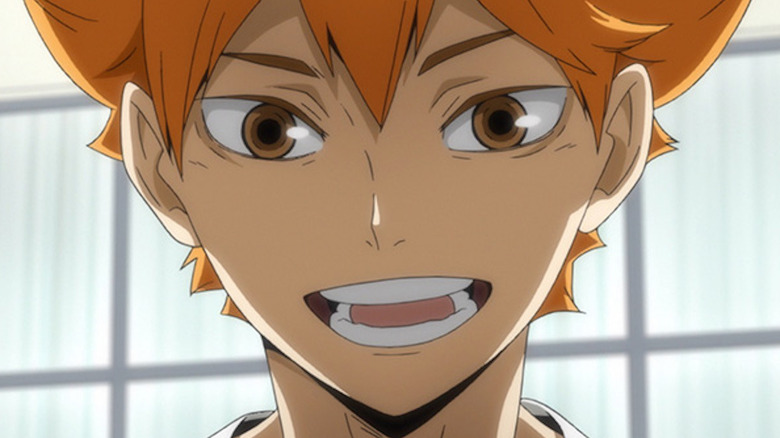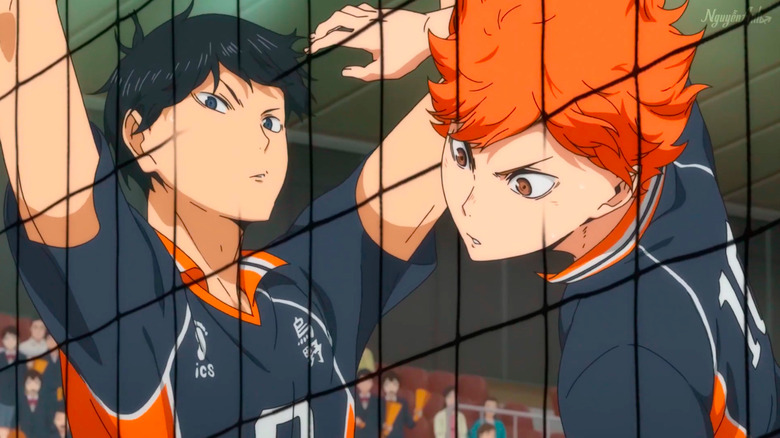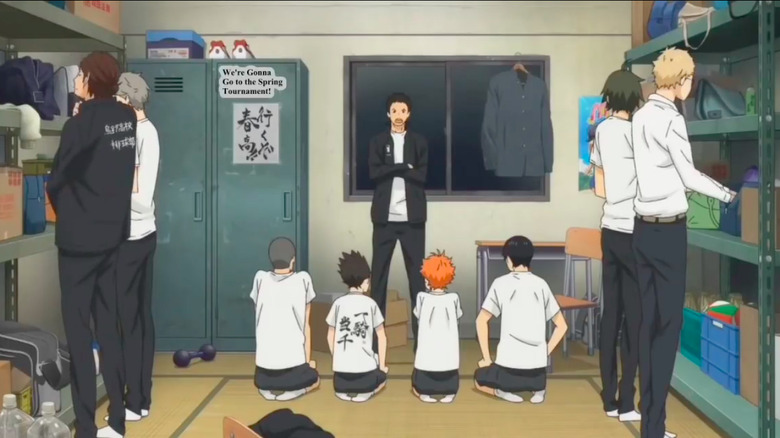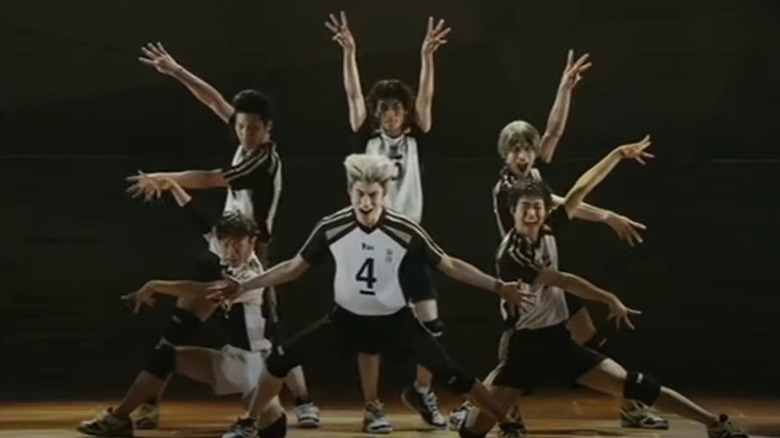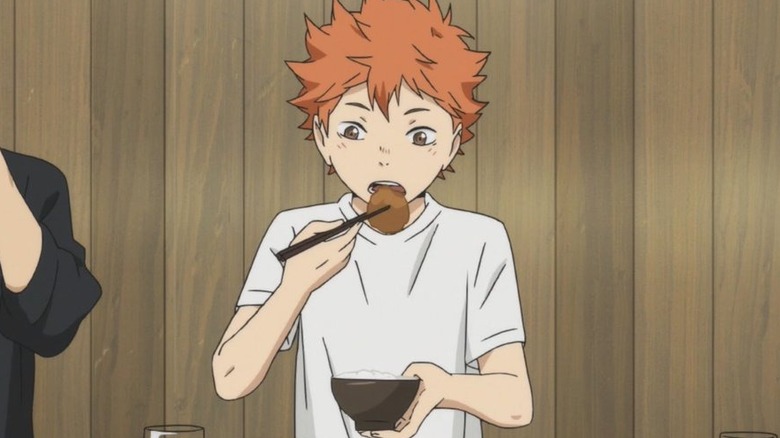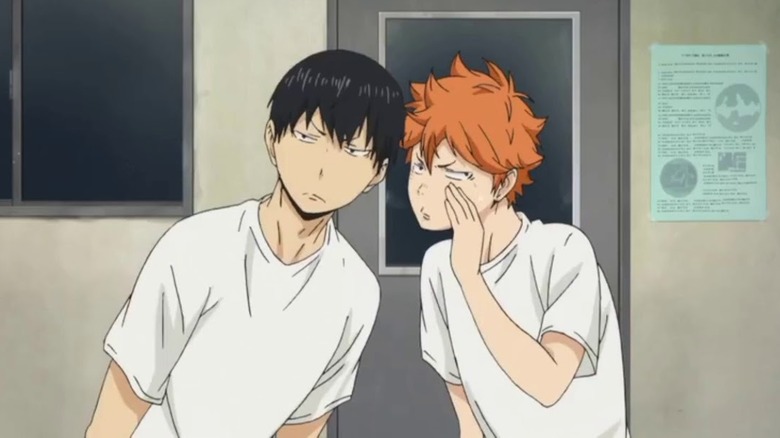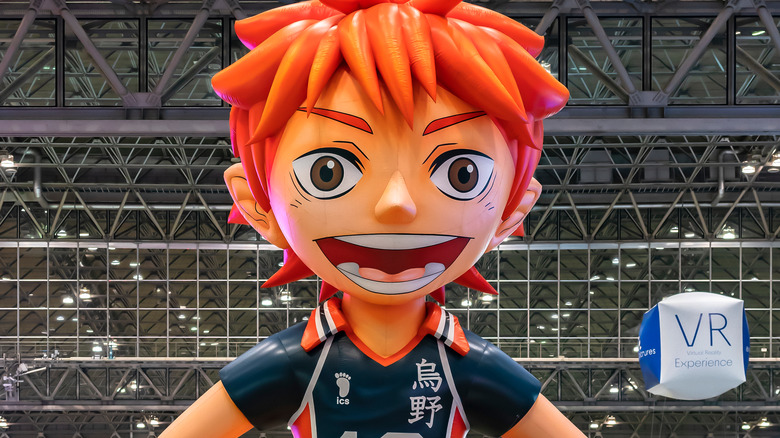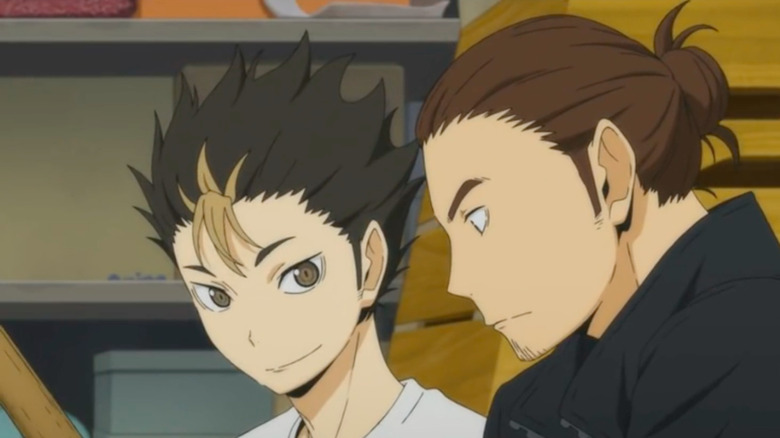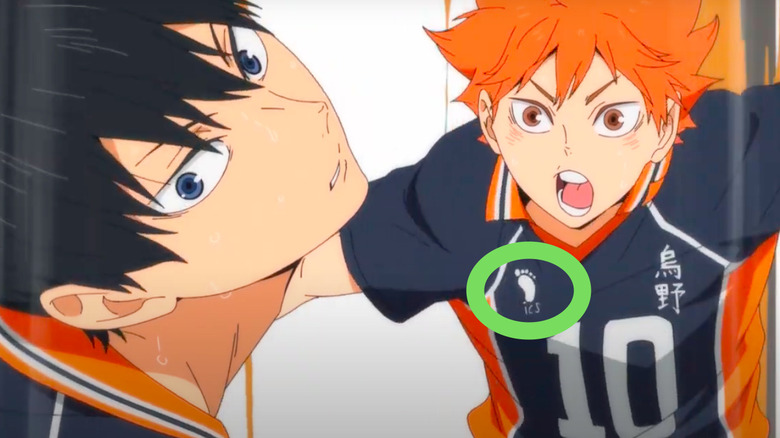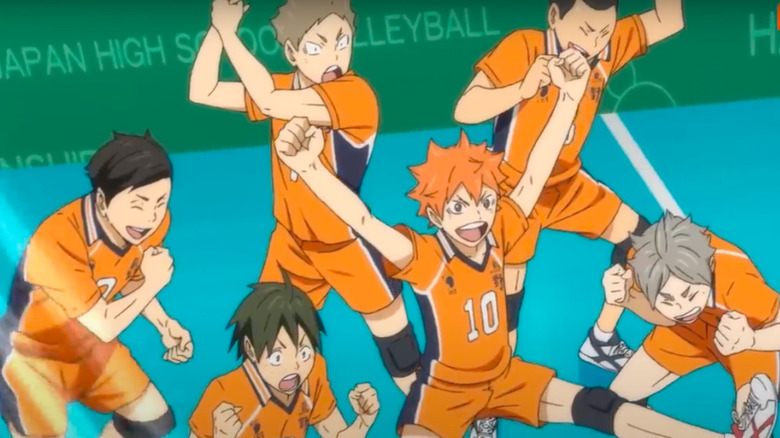Haikyuu!! Facts That Prove Just How Much The Series Has Changed The Anime Game
If you're in the mood for some wholesome, hard-working characters, and volleyball matches that will keep you on the edge of your seat, "Haikyu!!" is the anime you need. You don't need to know volleyball or even like sports to enjoy this show, and if you like to have a favorite character to show support for, "Haikyu!!" has a brilliant selection to choose from. Following the training and development of these characters is really what makes the show shine — the well-paced improvement and well-timed setbacks build up to satisfying and exciting pay-offs that really keep viewers hooked.
The "Haikyu!!" anime has been providing us with these high-stakes sporting thrills since 2014, but there's a lot of context and content that doesn't reach us in the West. Events, spin-offs, one-offs, collaborations, and all manner of merchandise are available in Japan, but it can be hard for fans in the U.S. and Europe to join in on the fun.
If you want to get a little peek of what sports clubs in Japan are really like, and what crazy collaborations "Haikyu!!" has been a part of, then keep reading. We've put together a list of untold truths about the "Haikyu!!" franchise, and we bet we'll be able to teach you something you didn't know!
The Inter-high tournament is real
The big goal for the Karasuno volleyball team in the very first season of "Haikyu!!" is a tournament known as the "Inter-high." When the team plays in the Spring Inter-High in Tokyo for the first time, they are amazed by the scale of the event — the huge arenas, the number of courts, the number of teams, and the TV filming crews are all beyond expectations. You may not know this, but the Inter-high championships are actually a real tournament in Japan, and they are just as big of a deal in real life as they are in "Haikyu!!"
When the Inter-highs were canceled in 2020, the team behind "Haikyu!!" put together a project in support of the students that wouldn't get to play that year. The staff collected 165 uniforms of real teams that had been hoping to play in the tournament that year and arranged them in a special commemorative photo.
For third-grade students who would graduate later that year, the cancellation meant that they lost their final opportunity to play in a high school tournament, which can be quite disheartening. The photo included a message to the players which can be translated into something like: "Your stories don't end here. From here on out, you can do anything you set your minds to!" The official "Haikyu!!" website also publishes free posters using anime and manga art which school volleyball clubs can use to recruit new members in style.
Japanese school clubs are intense
School sports clubs, or "Bukatsu," are a big deal in Japan, and the majority of students take part in a club from the age of 12 until they graduate high school at 18. The first thing a parent needs to prepare for when their child joins a sports club is the cost. Many teams aim for quality and for big competitions like the Inter-high, which means they need to have proper equipment that is well looked after. The second thing to prepare for is the amount of time students need to dedicate to their club.
In "Haikyu!!," Karasuno team members are seen turning up at the gym before school begins, and staying after school past sundown. They attend practice matches and tournaments on weekends, and club practice is still held around three times a week during the summer holidays. Because of all this, it can be easy to think that the protagonist and his team are going above and beyond the usual, but in actuality, all of these activities are standard practice in the world of Bukatsu. It's an extreme commitment for the kids, their parents, and even the teachers, who often need to look after the clubs during the summer and outside of work hours, but may not get any extra pay for it.
Unsurprisingly, club activities can also take up time students would otherwise spend studying, which can lead to some conflicts of interest. Just like the exam troubles Hinata has at the start of Season 2, real students can also miss out on important club outings if their grades are not up to scratch.
There's a Haikyu!! stage play
As odd as it may seem, stage plays are actually pretty common in the world of anime and manga. Once a manga has an anime adaptation, the next step is often a live-action drama or a theater production. Many popular franchises, such as "Naruto" and "Tokyo Ghoul," have produced stage plays, and "Haikyu!!" is no exception.
The "Hyper Projection Play: Haikyu!!" stage performance ran in 2015 and 2016 and used a mixture of manga art, video animation, and live performance to tell the story of the formation of the Karasuno team. The play involves a lot of dancing and singing, unlike the original material, but still has plenty of "Haikyu"-style goofy comedy. Merchandise for the show was also made, which can still be found on certain sites even in the West.
Although the play is in Japanese, performances held in Tokyo offered "subtitle glasses," which displayed English subtitles for the show when worn. A DVD of the performance was also released in 2015, which included bonus features such as interviews with the cast.
The play is a completely standalone project and does not involve any of the voice actors from the anime, but the world of anime theater has its own stars. For example, the actor playing Kageyama also starred in the "Prince of Tennis" musical, and both the Hinata and Kageyama actors starred in a "Naruto" stage play as well.
There are pop-up Haikyu!! cafes in Japan
Collaboration cafes are a standard "otakatsu" (which essentially means superfan activity) in Japan, and many popular franchises such as "Final Fantasy 14" or "Kirby" have permanent cafes in big cities like Tokyo and Osaka. For anime, however, it's more common to see "pop-up" cafes, which run for a limited time, often when new content for the franchise is released. For instance, when "Haikyu!! To The Top" was airing, a limited-time Animate X Haikyu!! cafe opened in Tokyo.
The cafe provided a place for fans to sit and eat themed food while surrounded by art of their favorite characters, and even be served by waiters in character cosplay. The drinks were themed after different Karasuno team members, such as Hinata's Orange Drink, or Kageyama's Concentration Cocoa, and each menu item came with a special coaster with original character art. Most themed cafes also serve as special pop-up shops, which sell limited-edition merchandise, often with special art drawn especially for the cafe.
Multiple franchises can sometimes join forces to present special cafes too, and in 2022, "Haikyu!!" collaborated with the popular video game "Monster Hunter: Rise" for a special Capcom cafe. These cafes can be especially popular, as fans get to see their favorite characters in outfits and contexts that would never exist in their own universes. However, collaborations are not limited to cafes; for instance, "Haikyu!!" has collaborated with an underwear brand called "Tutuanna" on a set of loungewear, and "My Hero Academia" has teamed up with Tobu Zoo in Saitama.
The Haikyu!! manga author's gender is unknown
Despite penning an award-winning manga with a successful anime adaptation and a loyal fan following, the author known as Haruichi Furudate is a mystery. The popularity of "Haikyu!!" has continued for over a decade now, and yet Haruichi's face has never been revealed. Since "Haikyu!!" is a "shonen" manga, meaning it is aimed at young boys, it is often assumed that Haruichi is male, and this is reflected in Viz Media's decision to use male pronouns in their official translation of the manga. However, Haruichi's gender has never been officially confirmed.
In the Japanese language, pronouns don't need to be used at all, so Haruichi is simply referred to by name and no gender-specific language is used. Other kinds of information on the author are also scarce, so it's not really possible to infer gender that way, either. Though Haruichi is a male name, it could easily be a pen name, and while we know that they played volleyball in junior high school, girls' volleyball clubs are just as common as boys'.
When Haruichi's comments or interviews are published on the "Shonen JUMP" website, the icon used is a strange bird character wearing some sort of suit. Additionally, some fans in Japan believe that "Haikyu!!" is written from a very female perspective, despite being published in a magazine for young boys — and they suspect that the author could be female.
There are JUMP Shops in Japan that specialize in Haikyu!! merchandise
In Japan, the "Haikyu!!" manga was serialized in the Weekly Shonen Jump magazine, alongside other big names such as "One Piece," "Naruto," "Hunter X Hunter," and many more. The magazine began in 1968 and is an iconic part of modern Japanese manga culture, which naturally means that Shonen Jump merchandise stores exist.
Across Japan, there are 12 of these JUMP Shops in cities such as Tokyo, Osaka, Nagoya, Hiroshima, and Fukuoka. "Haikyu!!" remains one of the most popular series that Jump owns — despite the fact that the manga has already finished — which means that the JUMP Shops devote a good portion of their display space to the "Haikyu!!" franchise.
Common merchandise types include t-shirts, stationery and stickers, rubber keyrings, acrylic keyrings, plushies, mini towels, acrylic stands, chopstick sets, lip balms and accessories, phone cases, card cases, and more. Merchandise for a show with many characters like "Haikyu!!" is often categorized and displayed by teams and characters, so fans can find their favorite, or oshi in Japanese, quickly and easily. The JUMP shops also sell special birthday badges of "Haikyu!!" characters each year when their birthday comes around.
Devoted "Haikyu!!" fans in Japan buy badges like this to display on special bags they carry around called itabags, which are named for how painfully expensive to make and tacky they are. Some itabags will be covered with different badges, pins, and keyrings of the same character, and others will use as many as 50 of the same badge over and over again. Depending on the size of the badge, its rarity, and the popularity of the character, fans can pay as much as $10 per badge, which is why the bags can get so expensive.
Nishinoya and Asahi are foils
The Karasuno team members Yu Nishinoya and Asahi Azumane serve as foils, intended by Furudate to compare and contrast against one another. This is shown through mirroring elements of their characters, such as their birthdays -– 10/10 and 01/01. Additionally, Asahi is the tallest member of the Karasuno team at 6' 1", and Nishinoya is the shortest at 5' 3" — a full inch shorter than Hinata, though it's hard to tell unless Nishinoya's hair is down.
There is also some interesting mirroring going on with their names, which are composed of three pairs of contrasting Chinese characters. First, there is 西谷 夕 (Nishi-noya-yu), which translates to west, valley, and evening. Next, we have 東峰 旭 (Azuma-ne-asahi), whose characters translate into almost the exact opposite — east, peak, morning sun.
Other notable contrasts between the two characters include their personalities. Nishinoya is boisterous and full of confidence, constantly taking part in silly behavior with Tanaka which draws attention to him. In contrast, Asahi is quiet and slightly shy, which leads to some confidence issues. Judging by these personalities alone, you might think that Nishinoya was the front-and-center ace of the team and Asahi the behind-the-scenes libero, but of course, it's actually the opposite.
There are some other examples of foils in "Haikyu!!," including the Chinese characters in Hinata's name and Tsukishima's name. Hinata's name is spelled with the character for sun, and Tsukishima's is spelled with the character for moon. This reflects their contrasting optimistic and pessimistic personalities and the fact that they sometimes struggle to get along with each other.
Kageyama and Oikawa are also seen as foils due to the way Oikawa contrasts Kageyama's play style and interpersonal skills. Kageyama is a brilliant setter because he has the physical ability to handle the ball with precision, but he's bad at communicating. Oikawa, meanwhile, doesn't have particularly precise skills, but he scores points by communicating with his teammates.
Karasuno's uniform brand is a parody of Asics
In Japanese anime, it's a very common sight to see big-name brands in animated form — at least, almost. Due to the fast-paced nature of the anime industry, clearing trademarks for use isn't considered a top priority, and most shows cut out this part of the process entirely. Instead, names like McDonald's, Apple, Starbucks, and Google undergo slight spelling or thematic changes that result in the birth of gems like Wacdnalds, Pear, Starducks, and Zoogle.
"Haikyu!!" is no different in this regard, and you may have spotted convenience stores named 8/11 and electronics by Somy hiding in the show. However, have you noticed the fake brand name on the Karasuno uniform before? The team sport a logo on the front of their uniforms of a foot and the letters "ics." When read with the Japanese word for foot, this logo spells Ashics and is a parody of the famous sports brand Asics which is especially well-known for its volleyball products.
This was an unconfirmed reference for a while, but when Asics asked Furudate about it, he confirmed the parody, explaining that the shoes he wore to play volleyball in school were from Asics. Since then, the sports brand has carried out campaigns with "Haikyu!!" featuring the art of characters with the real Asics logo emblazoned on their chests.
The show's title is an obscure term for volleyball
Japan is a country full of language-based easter eggs, puns, and hidden meanings. One of the biggest ones in "Haikyu!!" is that its title is an old term for volleyball in Japanese. The word is spelled with the Chinese character for throw or expel and the character for ball. This can actually work as a "Did you know?" fact even for native speakers, as the word is now obscure enough that many young Japanese people don't know it. Nowadays, the sport is referred to as "Barebōru" instead, which is simply volleyball written in Japanese characters.
A lot of language related to the sport is actually derived from English. Spikes and serves are still known by the same name in Japanese, and you'll also find the characters shouting English phrases during matches. These include "Donmai," which simply means don't mind, and is used to show support when someone drops the ball or makes a mistake. Next, fans of "Haikyu!!" fans have probably heard characters shout "Naisukī," which means nice kill. Teammates say this to each other when they hit a good spike and score a point.
Another phrase commonly heard is "Naissā," which means nice serve. This is often shouted by a teammate when a player is about to serve to cheer on other players, as serving is known to be tough on players' nerves. Finally, there is "Doshatto," which essentially is meant to communicate complete shutdown. This term is a mixture of English and Japanese and is used to congratulate team members when they shut down an enemy attack.
One funny thing to think about is that due to their poor grades in subjects like English, Hinata and Kageyama probably don't know that they're speaking English-based phrases in matches at all.
